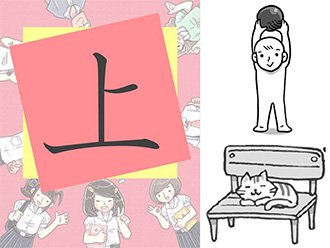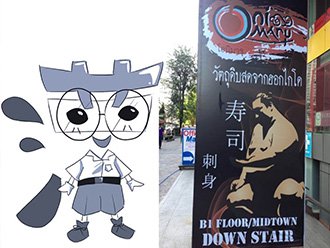2019 Japanese-Language Assistants’ Report: Involvement with Various Types of Japanese Language
The Japan Foundation, Bangkok
UEDA Shiho
One year, or half of my term at the Japan Foundation, Bangkok (hereafter referred to as "JFBKK"), has already passed. At JFBKK, Japanese-Language Assistants are involved in two major Japanese language education projects. One is secondary-school Japanese language education and the other is general Japanese language education.
Secondary-School Japanese Language Education
In order to keep up with the pace of modern globalization, Thailand is focusing on foreign language education at the secondary-school level. Especially in the upper secondary school (Mattayom 4-6), which corresponds to high school in Japan, students can choose one of the following eight subjects as a second foreign language: German, French, Japanese, Chinese, Arabic, Pali, Spanish or Italian. Thankfully, Japanese is one of the most popular languages, and many high school students are learning it.
JFBKK has been conducting various programs and training to support Thai teachers of Japanese language in secondary schools. I was in charge of the Kanji and listening comprehension classes at the Intensive Japanese Brush-up Training and assisted with that support. This training aims to improve the Japanese language skills of Thai teachers who teach Japanese at secondary schools. Teachers who normally teach at different schools in different parts of the country gather in one classroom, sit side by side, and take classes together for about a month. From another perspective, this training can also be said to function as a place to strengthen the network among the teachers. In the classroom, I kept this in mind and tried to give the teachers as many opportunities as possible to interact with each other. When I was asked, "Is this the correct answer?" I resisted the urge to say, "Yes, it is," and instead asked the trainees, "What do you think?" and consciously encouraged them to discuss their ideas together.
At the end of the training, a response on the questionnaire said, "It was very useful to be able to learn and discuss with other trainees." I was very happy to see that my secret goal of deepening relationships among the teachers had been achieved. I hope that the friendships that Japanese language instructors made through this training will give them confidence, which in turn will have a positive impact on the students studying Japanese under them.
General Japanese Education
As well as the above-mentioned training for secondary school teachers, JFBKK also offers Japanese-language courses for the general public. Thailand is home to many Japanese companies, and Bangkok, in particular, is filled with Japanese food, products and everyday goods. Not only Japanese goods, but also Japanese pop culture, such as anime and TV dramas, has permeated the country, and many Japanese-language course students have become interested in learning Japanese after being exposed to it. I am in charge of starter and elementary classes using the textbook "Marugoto: Japanese Language and Culture" (hereafter referred to as "Marugoto"). Students in each class are of a variety of ages and occupations, and the atmosphere is always lively and fun.
One of the great aspects of the Marugoto textbook is that it emphasizes the learning of Japanese culture together with the language. In the topic "Seasons and Weather," the phrase "Spring is warm" appears. One of the questions that students ask is what "warm" feels like. It's true that in Thailand, a country where it's always summer, it's rare to have a chance to feel the warmth of your blood flow through your body when it's been chilled to the core. Hmmm...I guess the closest thing I can think of is the feeling of comfort and security you get when you put on a jacket in a thoroughly air-conditioned room. Thinking about what feelings of warmth I could find in Thailand, I keenly felt the connection between language and culture. In the same topic, wind chimes and scary games are introduced as "Cool Summer" in Japan. It sparked a lot of conversation in class and various responses from students. One felt surprised and said, "Why don't you turn on the air conditioner? You can't survive the heat like that!" Another student said, "The idea of relieving the heat through the ears and head is interesting." Another student showed me a photo of a dessert and said, "In the past in Thailand people would beat the heat by eating a dessert like this."
Going Forward
As you can see, JFBKK offers plenty of opportunities to interact with people from various backgrounds, with the Japanese language as the common thread. Each student has their own ideas about who they want to speak Japanese with and in what situations, what kind of content they want to talk about, and what kind of things they would like to be able to do using Japanese in the future. In my future work, I would like to place importance on examining the background of the people I come into contact with, especially their aim in learning Japanese.

A Kanji learning video for high school students, which we began making in 2019. A scene that teaches the Kanji "上".
Also part of a Kanji learning video for high school students. A character named "Kanji-kun" is used to teach the key points of learning Kanji.
- What We Do Top
- Arts and Cultural Exchange [Culture]
- Japanese-Language Education Overseas [Language]
- Japanese-Language Education Overseas [Language] Top
- Learn Japanese-language
- Teach Japanese-language
- Take Japanese-Language Test
- Know about Japanese-language education abroad
- The Japanese-Language Institute, Urawa
- The Japanese-Language Institute, Kansai
- Japanese-Language Programs for Foreign Specified Skilled Worker Candidates
- Japanese Language Education for Japanese Children Resident Overseas and for the Descendants of Migrants
- Archives
- Japanese Studies and Global Partnerships [Dialogue]
- JF digital collection
- Other Programs / Programs to Commemorate Exchange Year
- Awards and Prizes
- Publications
